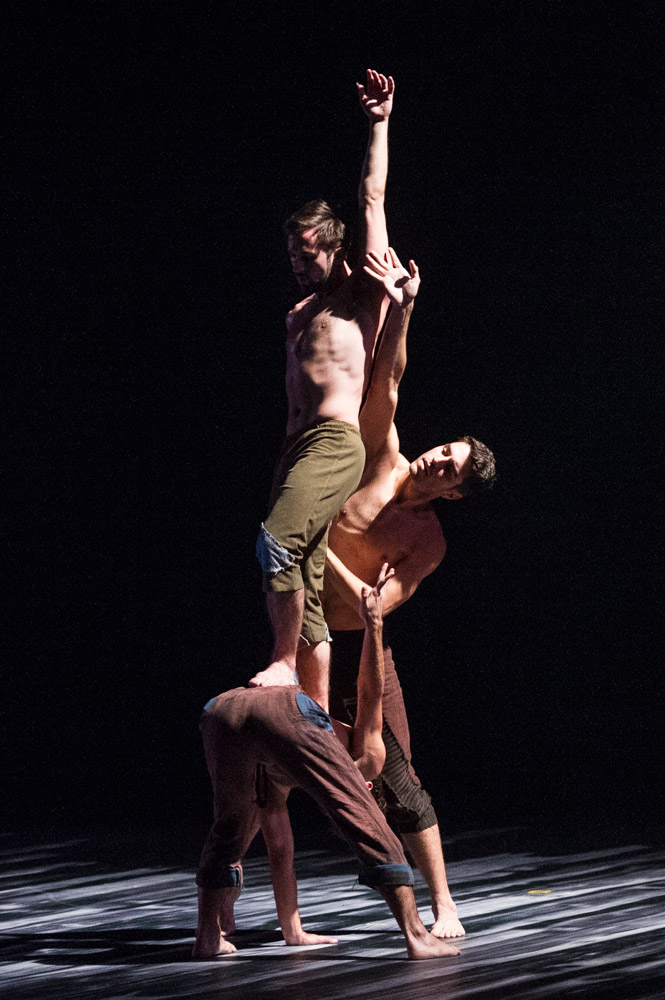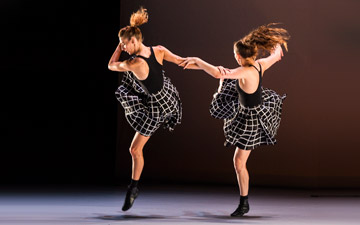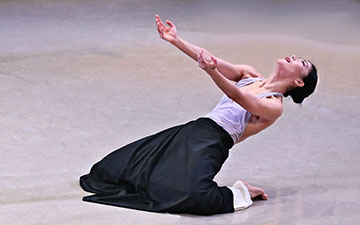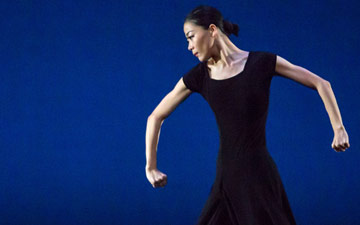
© Rose Eichenbaum. (Click image for larger version)
L.A. Dance Project
Harbor Me, Marth Graham duets (White, Star, Moon), Helix, On the Other Side
★★★✰✰
New York, Joyce Theater
27 July 2016
www.ladanceproject.com
www.joyce.org
LA Story
Since his quick exit from the Paris Opera Ballet, the choreographer and former director Benjamin Millepied has recommitted himself to the small Los-Angeles-based company he founded in 2012, L.A. Dance Project. The ensemble, which has been busy creating relationships with arts foundations and commercial entities like Van Cleef & Arpels, is now in New York, performing at the Joyce. With all the hoopla over Millepied, it’s sometimes easy to gloss over the company itself. Is it good? Is it producing interesting work? Is it worthy of its international profile?
The answer, based on the program at the Joyce, is mixed. One thing is sure: the dancers are very, very good. Even more, they are interesting. Each has a distinct personality, an individualized approach to the steps. All are intensely musical, versatile and indefaticable. The program, filled with highly physical, fast-paced, energetic works, was a killer; they sailed through with impressive élan, even joy. The repertory truly belongs to them; they have shaped it.

© Foteini Christofilopoulou. (Click image for larger version)
What of the works themselves? Well, here comes the “mixed” part. There is the inevitable dash of trendiness, the hat tip to a certain vein of feel-good semi-philosophical contemporary dance. In this case, the slot was filled by Sidi Larbi Cherkaoui’s Harbor Me, a piece for three men that is as handsome and tasteful as a moving Rodin sculpture, but which goes absolutely nowhere. (The music, by Park Woojae Geomungo, is melifulous and bland, a kind of world-music easy-listening.) Then, a surprising choice: a triptych of Martha Graham duets (the company has also performed Cunningham). And finally, what feels like something of a company signature: a duo of energetic, stylish, high-spirited pieces with a strong ballet backbone, by Justin Peck and Mr. Millepied.
Did I mention the dancers’ versatility? The Martha Graham duets (“White,” “Star,” and “Moon”) may not have looked very much like Graham as performed by the Graham Company – these dancers don’t have the tautness or the attack – but there is something tremendously refreshing about seeing them out of context, without the Graham baggage. The choreography stands up, and how. Graham’s use of stillness, of shape and muscle and the contrast between male and female energy made them perhaps the most striking works of the night, particularly when set against the busy-ness of the Peck and Millepied works that followed.
The choreography, less self-consciously dramatic than that of the “signature” Graham works, looks wise and pure; these qualities are further emphasized by the reimagined costumes, simple, elegant unisex tights and tunics by Janie Taylor, and the minimal score. The three duets are drawn from longer works, but were placed side by side in a 1957 documentary about Graham, with an original score by Cameron McCosh. They work well together as subtle meditations on the relationships between two people. The third duet, “Moon,” an excerpt from the 1952 work Canticle for Innocent Comedians, displays an almost galactic calm, reminiscent of the mood in Frederick Ashton’s Monotones. Anthony Bryant and Stephanie Amurao danced with quiet intensity, like planets on intersecting orbits.

© Rose Eichenbaum. (Click image for larger version)
Peck’s Helix, an exploration of partnering for three couples built around furious coiling and spinning movements, is a rather breathless tour de force. Why walk when you can run? The technique is mainly ballet, fast, clean, brilliant, athletic. The costumes, again by Taylor, consist of gray unitards and blue socks. The partnering, though based in a ballet vocabulary (promenades, finger turns), is refreshingly gender-neutral. As usual with Peck, the stage space is deftly used; dancers appear and disappear, running backwards at warp speed; patterns suddenly emerge, only to dissolve a moment later. Peck has a mathematical mind. But also an intensely musical one: one of the pleasure of his work is watching a movement morph from a drawn out legato into high speed, then reel itself back in again. The music, by Esa-Pekka Salonen, swells and soars, like early Stravinsky; in recording, however, it is greatly diminished. Millepied, who is musically sophisticated, should take this into account in his repertory choices: what will sound good in this or that venue? Helix needs an orchestra.
The evening closed with Millepied’s On the other Side, a work that closes his recent “Gems” trilogy, made in collaboration with Van Cleef & Arpels – shades of George Balanchine’s Jewels. However, there’s nothing particularly jewel-like about On the Other Side, except for the designs: a beautiful, colorful backdrop by the LA-based artist Mark Bradford that looks like a cross between a map of Venice and a piece of marbled Venetian paper, all dribs and drabs that respond gorgeously to the shifting light (lighting by Lucy Carter.) The costumes, too, are gorgeous, flowing jersey cotton pants and tops and summer dresses. Like Helix, it’s furiously busy, though it lacks that work’s excitement. The theme seems to be the dynamics within a group of young people: the connections between dancers, the affection and mutual support that flows between them. Everyone watches everyone else with concern. It’s a common theme for young, American ballet choreographers today, a legacy of Robbins perhaps. Troy Shumacher, Myles Thatcher and even Peck come to mind. It’s become a bit of a cliché. The Philip Glass score, too, feels like throwback.

© Foteini Christofilopoulou. (Click image for larger version)
The real problem with On the Other Side, though, is that it drags on. Genuinely brilliant passages, like a skittering, flickering, happy-go-lucky solo for Lila Rúriksdóttir, and interesting lifts involving multiple dancers, simply get lost in the profusion. It’s a seldom-remarked-upon problem with Glass: his pieces tend to be long and repetitive, and choreographers end up marking time by piling on the steps.
It’s clear, though, that Millepied has built a strong and promising ensemble of dancers. With his mix of smarts and connections, he may yet develop it into something really interesting.

















“without the Graham baggage”? We should all be so burdened to look like Yuriko in the final duet. What a fatuous comment. The dancers struck decorative poses without a hint of tension, stakes, or without the Graham baggage.. Physically versatile yes, but stylistically in the only work of significant tone difference (Graham) they sank. You clearly do not have the qualifications to assess Graham if this glib response is your take away. Shame.